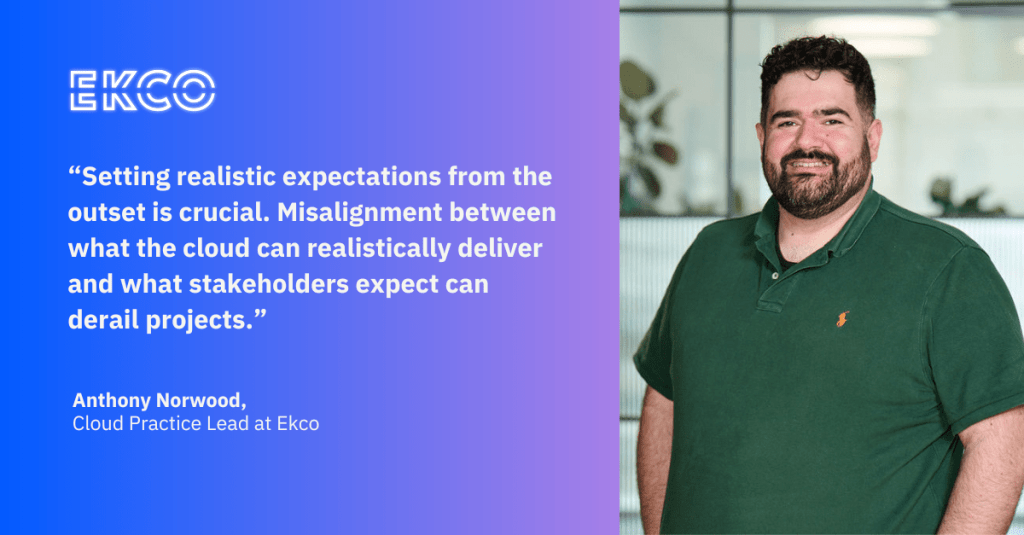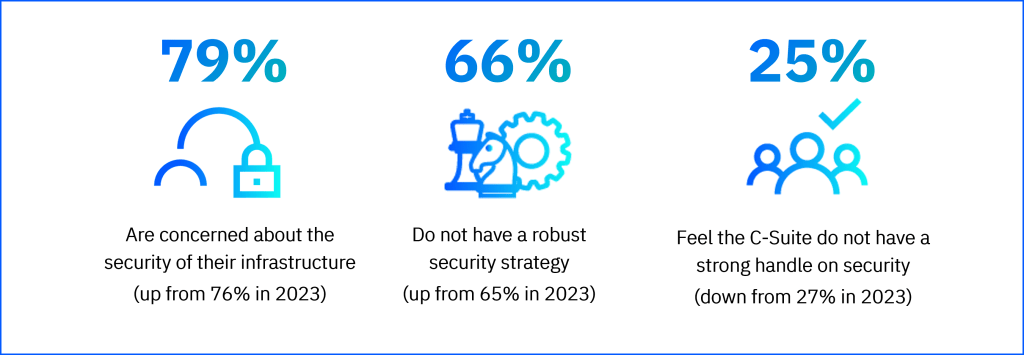5 Reasons Cloud Projects Fail (And How To Keep Yours On Track)
The cloud offers incredible potential for businesses, promising scalability, cost savings, and flexibility. However, the reality often falls short of expectations. According to our 2024 Infrastructure Modernisation Survey, only 32% of cloud projects meet all their objectives. This statistic underscores a significant challenge facing IT leaders today. In this blog we explore why many cloud projects fail to meet expectations and how to navigate these pitfalls successfully.

1) Unrealistic Expectations
The Pitfall of Over-Optimism
One of the primary reasons cloud projects fail is due to unrealistic expectations. Many organisations enter cloud migration with an overly optimistic view of the benefits and an underestimation of the challenges. The allure of cost savings, improved performance, and scalability often overshadow the practicalities involved.
In our recent Modern Cloud Insights webinar, Anthony Norwood, Cloud Practice Lead, emphasised, “Setting realistic expectations from the outset is crucial. Misalignment between what the cloud can realistically deliver and what stakeholders expect can derail projects.”
Setting Realistic Goals
To avoid this pitfall, IT leaders must set realistic goals. This involves a thorough analysis of current infrastructure, clear understanding of business requirements, and realistic timelines for migration. Engaging with stakeholders early and often ensures that everyone is on the same page, mitigating the risk of unmet expectations.
2) Insufficient Stakeholder Involvement
The Importance of Collaboration
Cloud projects often fail due to insufficient involvement from key business stakeholders. Successful cloud migration is not just a technical exercise but a business transformation. It requires input from various departments to ensure the new infrastructure meets organisational needs comprehensively.
Collaboration allows for open discussions about timelines, costs, and trade-offs. When everyone is on the same page, surprises are minimised. Involving stakeholders early ensures:
- Shared Vision and Alignment: Effective collaboration unites diverse perspectives, including those from IT teams and business units, fostering a shared vision for the project. This alignment is crucial as it ensures that everyone understands the project’s goals, benefits, and potential challenges. With a unified vision, stakeholders are better prepared to contribute meaningfully to the project’s success.
- Risk Mitigation: Engaging stakeholders early and consistently allows for thorough risk assessment. By identifying potential roadblocks, security concerns, and compliance requirements, teams can proactively address them. Regular communication ensures that risks are managed effectively.
- Requirements Gathering and Prioritisation: Stakeholders provide critical insights into functional and non-functional requirements. Their involvement ensures that the project team captures all necessary features and prioritises them appropriately. This prevents scope creep and keeps the project on track.
- Change Management: Cloud projects often involve significant organisational changes. Stakeholders help manage this transition by communicating with end-users, addressing concerns, and facilitating training. Their involvement fosters smoother adoption of new technologies.
- Feedback Loop: Regular collaboration enables a feedback loop. Stakeholders provide insights during development, testing, and deployment. Their feedback ensures that the project remains aligned with business needs and adapts to changing requirements.
Jonathan Bailey, Cloud Engineer, noted in the webinar, “Defining your business requirements at the start is absolutely essential. Lack of business involvement leads to scope creep.”
Strategies for effective involvement
While technology outcomes are important, positioning the project with clear business outcomes is crucial to gaining buy-in from stakeholders. For instance, if the workforce requires secure access to data from anywhere, it is easier to meet this need using a cloud platform rather than focusing on the need to implement complex efficiency and scalability requirements.
To ensure effective stakeholder involvement:
- Incorporate stakeholders at the project outset. Their input and concerns shape the project direction from the start.
- Conduct workshops and meetings with representatives from all relevant departments.
- Create a detailed requirements document that captures the needs and expectations of each stakeholder.
- Maintain regular communication throughout the project to address any concerns promptly.
3) Cost Overruns
The Hidden Costs of Cloud Migration
Another major reason for cloud project failures is cost overruns. According to Ekco’s Infrastructure Modernisation Report, 66% of those surveyed who had just completed a cloud project, had to make compromises around cost. Several common mistakes contribute to budgeting compromises:
- Underestimated support needs: Choosing an inexperienced migration partner or relying solely on an internal team can lead to mistakes and rework, increasing costs.
- Emphasising “Lift and Shift”: prioritising a quick “lift and shift” approach—moving workloads to the cloud without modification—can be counterproductive, as some applications may be more efficient if rewritten or replaced with cloud-native alternatives.
- Incomplete Application Assessments: Incomplete workload assessments result in vague migration requirements and scope creep. Properly assessing workloads is crucial for accurate budgeting.
- Data Transfer and Training Expenses: The initial migration phase incurs significant costs related to data transfer, re-architecture, and training. Ongoing cloud usage costs can escalate without proper monitoring and optimisation.
- Poor Landing Zone Design: Neglecting the architecture and implementation of the cloud environment where workloads are migrated to can increase security and compliance costs.
- Under-provisioning or Over-provisioning: Failing to allocate sufficient resources or paying for unnecessary ones harms business processes and leads to further unexpected expenses even once a project is complete.
Michal Skackov, Director of Strategy and Innovation, highlighted, “Security features can come at higher costs. Many organisations underestimate these costs, leading to budget overruns.”
Effective Cost Management
Effective cost management starts with a comprehensive cost analysis:
- Use cloud pricing calculators to estimate costs accurately, including potential egress charges.
- Consider the costs of necessary security features and ongoing support.
- Implement monitoring tools to track cloud usage and optimise resource allocation continuously.
4) Underestimated Support Needs
The Challenge of Ongoing Support
Underestimating the support needed post-migration is another common issue. The transition to cloud requires ongoing management and support to ensure the infrastructure remains optimised and secure. Many organisations fail to account for the additional resources required to manage the new environment effectively.
Arthur Dumont, Project Manager, pointed out, “Lack of information on the current status of the infrastructure and insufficient cleanup and testing contribute to project delays and increased costs.”
Building a Support Plan
To address support needs:
- Develop a detailed support plan that outlines the resources required for ongoing management.
- Invest in training for internal teams to bridge any skill gaps.
- Consider partnering with a Managed Service Provider (MSP) such as Ekco to leverage external expertise.
5) Lack of a Comprehensive Security Strategy
Security Concerns
Security is a significant concern for businesses moving to the cloud. The survey revealed that 79% of respondents were worried about the security of their cloud infrastructure. Misconfigurations and lack of robust security measures can leave organisations vulnerable to cyber-attacks. Without putting a proper security strategy in place upfront, it is challenging to maintain visibility over the entire cloud infrastructure, making it harder to identify and rectify misconfigurations further down the line.

Implementing Strong Security Measures
To ensure a secure cloud environment:
- Conduct a thorough security assessment before migration.
- Implement robust access controls, encryption, and continuous monitoring.
- Regularly update security protocols and train staff on best practices.
- Ensure you get leadership buy-in for security initiatives upfront. According to our survey only 25% of C-Suite have a strong handle on security
Conclusion
The high failure rate of cloud projects can be mitigated with careful planning and realistic goal setting. By involving stakeholders early, managing costs effectively, ensuring ongoing support, and prioritising security, organisations can navigate the complexities of cloud migration successfully.
Cloud projects are not merely IT initiatives but significant business transformations. Addressing these challenges head-on will position businesses to harness the full potential of cloud computing, driving innovation and growth in the digital age. Success in the cloud requires a blend of technical expertise and strategic business planning.
If you are about to undertake a cloud project or you are looking to review your current cloud infrastructure, get in touch with our team to discuss your requirements.

Question?
Our specialists have the answer



